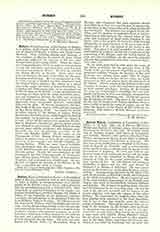

Hubert, MILITARY ORDERS OF Saint.—I. The highest order of Bavaria, founded in 1444 or 1445 by Gerhard V, Duke of Julich, in commemoration of a victory gained on St. Hubert’s day (November 3); some, however, date the establishment as late as 1473 and 1475. After being held by collateral branches of the family, and passing through many political changes, the Duchy of Julich, at the beginning of the eighteenth century, was under the jurisdiction of the Electoral Prince Johann Wilhelm, Duke of Neuberg. In 1708 he restored the Order of St. Hubert, which had fallen into desuetude, vesting the grandmastership in his own person, and conferred the cross of the order on a number of his courtiers, together with generous pensions, on condition that a tenth part of these moneys be set aside for the poor, and a goodly sum be distributed on the day of their reception into the order. The order was confirmed (March 30, 1800), by Maximilian, King of
Bavaria, who stipulated that each capitular should have filled for at least six years the post of commander in the Order of the Crown of Bavaria, which he himself had instituted. The chapter was assigned for October 12, and the number of capitulars fixed at twelve. According to Schoonebeck the original collar of the order was composed of small horns obtained in the chase; later it was of gold, the forty-two links bearing alternately the representation of the conversion of St. Hubert and I. T. V—the initials of the device of the order. The cross is of gold enamelled in white and surmounted by a crown; on one side is represented the conversion of St. Hubert, with the Gothic legend In traw vast (firm in fidelity); on the other the imperial orb and the inscription In memoriam recuperatae dignitatis avitae 1708.
II. An order instituted in 1416 under the name of the Order of Fidelity by the principal lords of the Duchy of Bar, for the purpose of putting an end to the perpetual conflicts between the Duchies of Bar and Lorraine, and uniting them under Rene of Anjou. The order, which was to last for five years, was made perpetual in 1422 and placed under the patronage of St. Hubert. On the cession of the Duchies of Bar and Lorraine to France, Louis XV confirmed the knights in their ancient privileges. During the Revolution the order was maintained at Frankfort, but was reorganized in France in 1815, and formally recognized by Louis XVIII the following year. It did not survive the Revolution of 1830. The cross of the order bore on one side the image of St. Hubert kneeling before a cross visible between the horns of a stag; and on the other the insignia of the Duchy of Bar, with the inscription: Ordo nobilis s. Huberti Barensis, institutes anno 1416.
F. M. RUDGE

